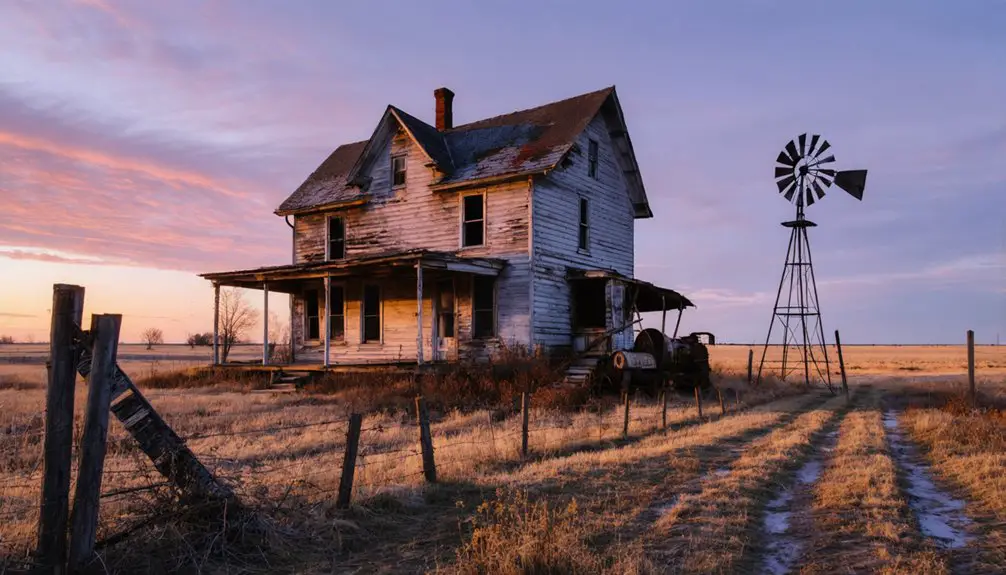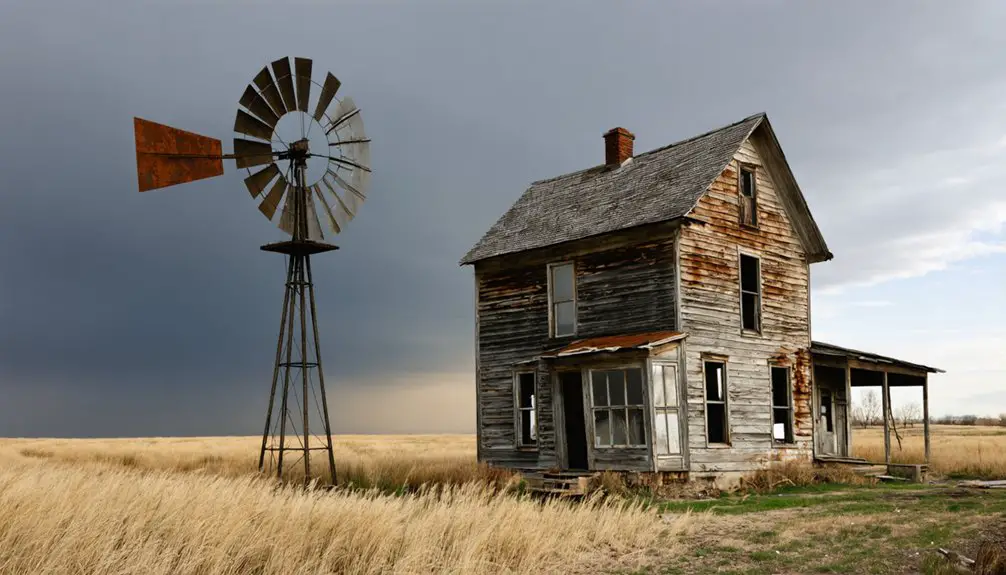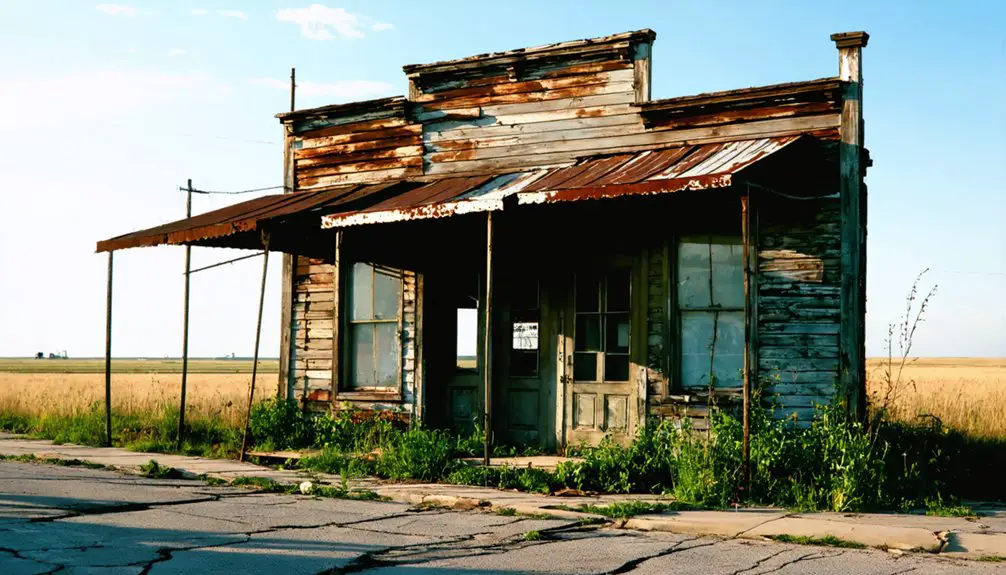You’ll find Violet, Nebraska among the ghost towns that emerged along the Chicago, Burlington and Quincy Railroad in the late 1800s. The settlement flourished as an essential agricultural shipping point, complete with mills and stores serving railroad workers and travelers. After thriving through pioneering hardships like grasshopper plagues and drought, the town declined when railroad service ended. Today, only scattered foundations and cellar holes remain, while nature slowly reclaims this piece of Nebraska’s frontier heritage.
Key Takeaways
- Violet was established as a railroad town by the Chicago, Burlington and Quincy Railroad in the late 19th century.
- The town flourished as an agricultural shipping point and commercial hub for railroad workers and travelers.
- Economic decline and discontinuation of railroad service led to the town’s abandonment and ghost town status.
- Only scattered foundations, cellar holes, and overgrown ruins remain at the original townsite today.
- The former town area has been reclaimed by nature and converted back to agricultural land for farming and grazing.
The Rise and Fall Along the Railroad
When the Chicago, Burlington and Quincy Railroad expanded through Nebraska in the late 19th century, it established Violet as one of many strategic stops along its growing network.
You’d have found a bustling hub of commerce, where mills and stores emerged to serve railroad workers and travelers. The railroad’s significance transformed Violet into an essential agricultural shipping point, connecting local farmers to broader markets. Like many abandoned railroad towns, Violet’s development paralleled other settlements that sprang up during the great railroad expansion of the 1870s.
Construction workers, including many who earned fifteen cents per hour, helped establish the vital infrastructure that would shape the region’s development.
But by the late 20th century, economic shifts reshaped Violet’s destiny. As trucking competition grew and rail routes shifted priorities, the town’s lifeblood began to fade.
When the railroad eventually discontinued service, businesses lost their significant market connections. Without the railroad’s economic engine, Violet’s population dwindled as residents sought opportunities elsewhere, leaving behind empty buildings and quiet streets – remnants of its once-thriving railroad era.
Life in Early Settlement Days
Before Violet became a railroad town, hardy pioneers from diverse backgrounds – including Yankee, English, German, and Swedish settlers – carved out homesteads in the Nebraska wilderness.
You’d have found these early settlers living in primitive sod houses and dugouts, battling nature’s fury with minimal protection from harsh weather.
Pioneer hardships were relentless: grasshopper plagues devastated crops between 1874-1877, while drought and unstable land prices threatened their survival.
Yet community resilience emerged as families supported one another, establishing essential trades and services.
In times of hardship, pioneer families banded together, building a network of shared skills and mutual support.
They’d travel by ox teams along crude trails, connecting to critical supply routes like the Overland Trail linking Nebraska City to Fort Kearny.
Water sources proved essential – you’d see homesteads clustering near creeks and rivers where settlers could sustain their crops and livestock.
By 1873, education was expanding rapidly across the region with 33 school districts serving the growing pioneer population.
What Remains Today
Today in Violet, you’ll find little more than scattered remnants where a bustling Nebraska town once stood. A remnants analysis reveals only foundations and cellar holes marking former homes and businesses, now heavily decayed and collapsed.
Like many ghost towns across Nebraska, Violet’s scattered remains resemble one of many spots on a Dalmatian coat.
Much like the old motel turned market in Broadwater, any surviving structures have been repurposed over time.
Nature’s reclamation is evident everywhere – trees grow through ruins while wild grasses and shrubs dominate the landscape.
The post office that once served as the town’s lifeline has long since closed, and no active businesses or services remain within the original townsite.
You’ll spot occasional historical markers that help preserve Violet’s memory, though they’re sparse and sometimes difficult to locate.
The land itself has largely returned to agricultural use, with private owners utilizing the area for farming and grazing where streets and buildings once defined this prairie community.
Capturing the Ghost Town’s Legacy
Through dedicated preservation efforts, Violet’s legacy lives on in various historical records and documentation methods. Local historical societies and preservation groups work diligently to maintain the town’s memory through systematic documentation and digitization of records. Similar to Amboy’s old mill, remnants of Violet’s industrial past serve as physical reminders of its economic foundations. The dedication to historical preservation mirrors that of the Kansas silverdale limestone used in notable Nebraska structures.
Historical societies stand guard over Violet’s legacy, preserving its memory through meticulous documentation and digital archiving efforts.
You’ll find the story of this Nebraska ghost town preserved through multiple channels that capture its unique heritage.
- Historic maps and land development records reveal the town’s establishment and evolution
- Photographic collections and newspaper archives document daily life and community changes
- Oral traditions from former residents and their descendants provide personal perspectives
- Digital platforms now make these preservation efforts available to researchers worldwide
These preservation efforts guarantee that you can explore Violet’s past through both tangible artifacts and intangible cultural heritage, keeping the spirit of this once-thriving rural community alive for future generations.
Exploring Historical Landmarks
Standing as silent witnesses to Nebraska’s pioneer history, Violet’s remaining landmarks tell the story of a once-thriving agricultural community.
You’ll find echoes of pioneer life in structures that once served as essential community hubs – from the schoolhouse where children learned to the post office that connected residents to the outside world.
The town’s historical preservation efforts have focused on key sites that showcase its community heritage, including railroad-era buildings and agricultural facilities like the blacksmith shop.
Similar to other Nebraska ghost towns, Violet’s landmarks reflect the region’s economic evolution.
You might discover remnants of commercial buildings, church foundations, or rural cemeteries that paint a picture of daily life during the town’s heyday, when cream trucks and egg deliveries kept the community connected.
Like the Hilfiker general store, many local businesses served as vital gathering places for both settlers and Indigenous people of the region.
The area’s extensive history of abandoned settlements is evident, with 34 ghost town sites documented throughout Sarpy County alone.
Frequently Asked Questions
What Was the Population of Violet During Its Peak Years?
While exact records aren’t conclusive, you’ll find that Violet’s history shows a peak population of approximately 100 residents during the late 1800s, before its population decline mirrored other Nebraska railroad towns.
Are There Any Surviving Descendants of Original Violet Settlers Still Nearby?
You won’t find documented descendant stories or family connections from Violet’s original settlers in the area today. Migration patterns and poor record-keeping make tracing these ancestral lines nearly impossible.
Was There a Cemetery Established in Violet During Its Existence?
You can’t definitively know if cemetery records existed, as historical documentation doesn’t confirm burial sites. While many Nebraska ghost towns had cemeteries, Violet’s remains unverified through available primary sources.
Did Any Notable Crimes or Mysterious Events Occur in Violet?
Unlike Salem’s dark past, you won’t find any unsolved mysteries or ghost sightings here. Historical records show Violet remained remarkably peaceful, with no documented notable crimes or supernatural events during its existence.
What Natural Disasters Significantly Impacted the Town of Violet?
You’ll find river flooding caused the most damage to the town, forcing its relocation in 1886. While Nebraska’s prone to tornado destruction, there’s no specific record of tornadoes hitting this settlement.
References
- https://www.youtube.com/watch?v=l3s2qhSxis8
- https://hauntedhouses.com/nebraska/joslyn-castle/
- https://www.youtube.com/watch?v=PAm9BHIpjL0
- https://www.instagram.com/reel/CzENL9JIqnc/
- https://history.nebraska.gov/finding-nebraskas-ghost-towns/
- https://en.wikipedia.org/wiki/Belmont_Tunnel_(Nebraska)
- https://visitnebraska.com/trip-idea/explore-7-authentic-ghost-towns-nebraska
- https://www.education.ne.gov/wp-content/uploads/2017/07/wtnh_3.pdf
- https://history.nebraska.gov/blog/
- https://nebraskalegislature.gov/pdf/bluebook/2008/60-69.pdf



